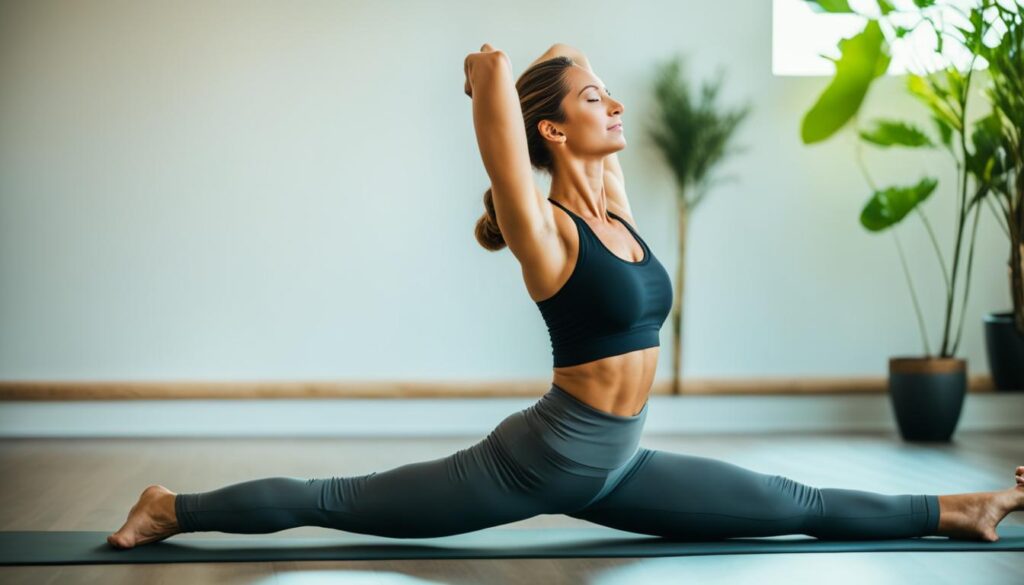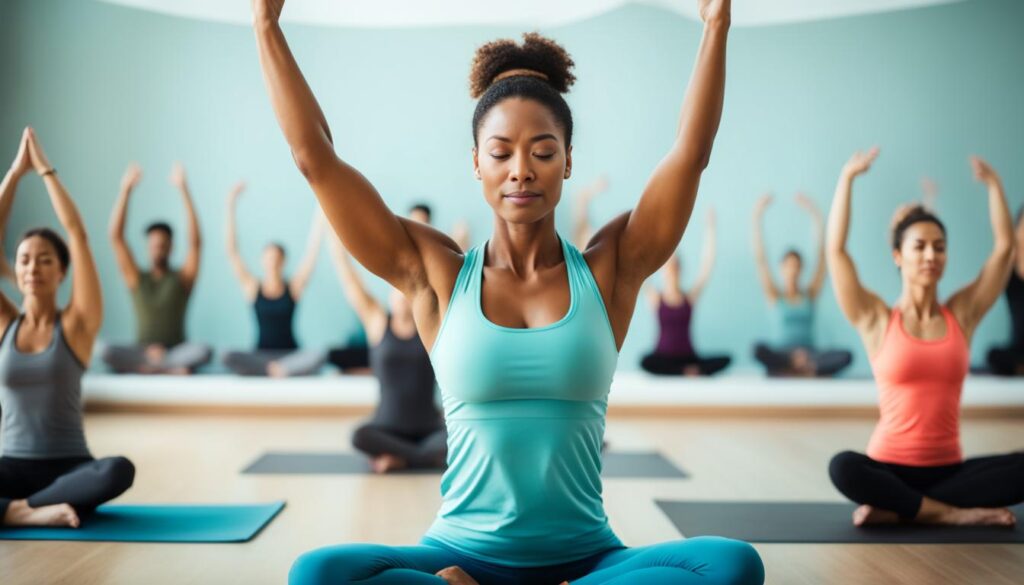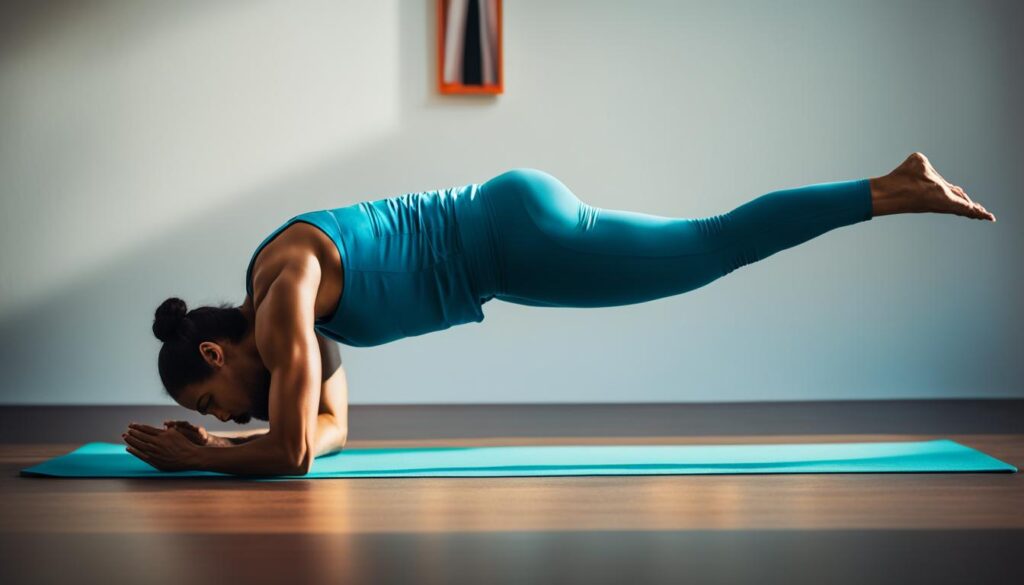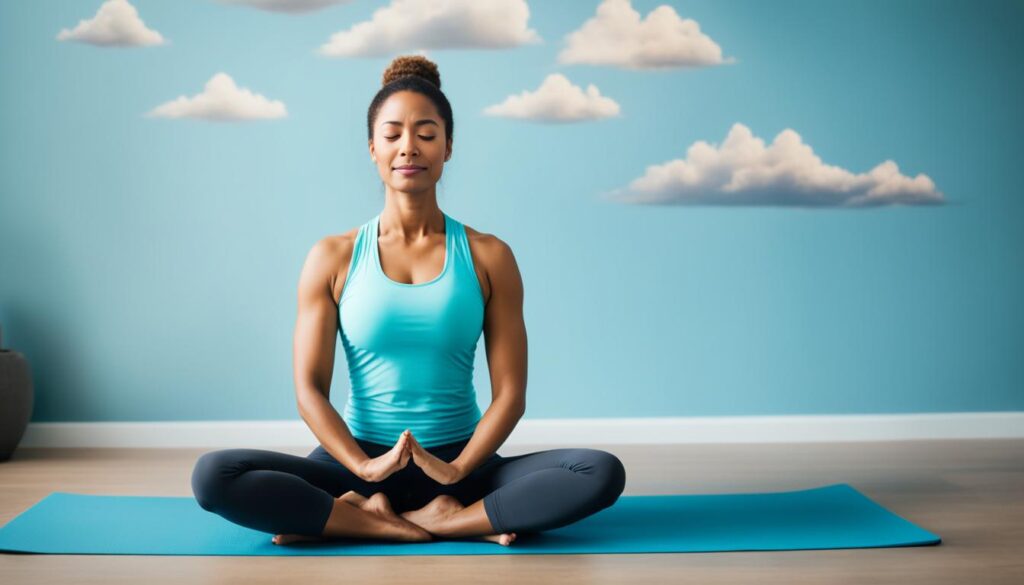If you suffer from back pain, you know how difficult it can be to find relief. Whether it’s a persistent ache or a sudden sharp pain, it can make everyday activities challenging. Fortunately, you don’t have to rely on pain medication to find relief. One of the most effective natural treatments for back pain is yoga. In this section, we will explore specific yoga poses that target back pain and improve spinal health.
Key Takeaways:
- Yoga poses can effectively alleviate back pain.
- Specific yoga poses are designed to target back pain and improve spinal health.
- Practicing yoga regularly can reduce back pain and enhance overall well-being.
- Consult a qualified yoga instructor or healthcare professional before starting any new exercise regimen.
Understanding the Benefits of Yoga for Back Pain
If you suffer from back pain, incorporating yoga into your routine can provide numerous benefits beyond just alleviating pain. Through consistent practice, yoga can help strengthen your back muscles, improve spinal flexibility, and support overall spinal health. Yoga is an effective and natural alternative to medication or surgery for many people.
Yoga has been shown to be particularly effective in providing back pain relief through gentle movements, breathing exercises, and relaxation techniques. These holistic practices can help you manage stress and tension, which can often exacerbate back pain. By releasing tension and stress, you can experience a reduced sensation of pain and discomfort.
Furthermore, yoga can also improve your posture and align your spine correctly, leading to spinal health benefits. Practicing yoga postures can naturally align your spine, promote balance, and increase mobility.

“In a world where we sit for most of our day and lead increasingly sedentary lives, yoga provides an accessible and practical solution to alleviate and prevent back pain.”
Cat-Cow Pose: A Gentle Stretch for the Spine
If you’re experiencing back pain and are looking for a gentle way to stretch and relieve tension in your spine, the Cat-Cow Pose is a great place to start. This pose involves moving between two positions – the cat pose and the cow pose – while focusing on your breath.
To perform the cat pose, start on your hands and knees with your wrists directly under your shoulders and your knees directly under your hips. As you exhale, round your spine and tuck your chin into your chest, imagining that you’re pulling your belly button towards your spine.
Next, move into the cow pose by inhaling and arching your back, lifting your tailbone towards the ceiling, and looking up towards the sky. Repeat this sequence of poses for several breaths, focusing on the movement of your spine.
Practicing this pose regularly can help improve spinal flexibility and relieve tension in your back muscles.

Tips:
- Take slow, deliberate breaths as you move through the poses.
- Modify the pose as needed by placing a cushion under your knees or using a chair for support.
“The Cat-Cow Pose is a wonderful way to warm up the spine and release tension in your back muscles.” – Yoga Instructor, Jane Smith
Downward Facing Dog: Strengthening the Back and Core
If you’re looking for a versatile yoga pose that targets both your back and core muscles, look no further than Downward Facing Dog. This pose is great for stretching out your spine while also working to strengthen your back muscles and core.
To get into the pose, begin on your hands and knees with your wrists directly under your shoulders and your knees under your hips. On an exhale, push firmly into your hands as you lift your knees off the floor and straighten your legs, coming into an inverted V-shape.
Make sure your hands are shoulder-width apart, your feet are hip-width apart, and your fingers are spread wide. Press down through your palms and lift through your hips, keeping your head and neck relaxed.
Not only does Downward Facing Dog help to alleviate back pain, but it can also improve spinal alignment and posture. Plus, it’s a great pose for building strength in your arms and shoulders as well.

If you want to increase the challenge of the pose, you can try lifting one leg off the floor and extending it behind you, alternating between sides. This variation adds an extra element of core stability and balance to the pose.
Practice Downward Facing Dog regularly to help alleviate back pain and build strength and stability in your core and back muscles.
Child’s Pose: Release and Relaxation for the Back
If you’ve been sitting at a desk all day or experiencing discomfort in your back, Child’s Pose is an excellent posture to try. Often used as a resting pose during yoga practice, this gentle stretch can also provide a release for your back.

Begin in a kneeling position with your toes touching and your knees hip-width apart. Exhale and lower your torso between your thighs. Allow your forehead to rest on the floor, extend your arms in front of you, and place your palms facing down on the floor.
Take deep breaths in and out, feeling the stretch in your back and hips as you exhale. This pose can help release tension, reduce pressure on the spine, and promote relaxation.
Hold this pose for several breaths or as long as desired. To come out of the pose, inhale and slowly roll up to a kneeling position, resting in a seated position for a few moments before moving on to the next posture.
Bridge Pose: Strengthening the Lower Back
If you’re looking for a yoga pose that offers both strength-building and pain relief, look no further than Bridge Pose. This energizing pose targets the lower back and glutes, working to alleviate discomfort caused by prolonged sitting or standing and poor posture. Bridge Pose is an effective yoga pose for back pain, providing numerous physical and mental benefits.

Bridge Pose is one of the best yoga poses for lower back pain. By improving spinal stability and strengthening the muscles that support the lower back, this pose can reduce the intensity and frequency of pain. It also helps to increase flexibility in the back, hips, and thighs, improving overall mobility and range of motion.
How to do Bridge Pose:
| Step | Action |
|---|---|
| 1 | Lie on your back with your knees bent and your feet flat on the floor, hip-distance apart. |
| 2 | Press your feet and palms firmly into the floor, lifting your hips off the ground. Keep your thighs parallel and your shins perpendicular to the floor. |
| 3 | Interlace your fingers beneath your back and press your arms into the ground, keeping your shoulders tucked under and your chin tipped slightly towards your chest. |
| 4 | Hold for 30-60 seconds, breathing deeply into your belly. |
| 5 | Release the pose by gently rolling your spine down to the floor, vertebra by vertebra. |
As with any new exercise, it’s important to practice Bridge Pose with proper alignment and technique. Consult a qualified yoga instructor or healthcare professional if you experience any pain or discomfort during practice.
Sphinx Pose: Opening Up the Chest and Lengthening the Spine
Another powerful pose for improving spinal health is Sphinx Pose. This mild backbend is excellent for opening up the chest and lengthening the spine, making it great for people who sit for long periods.
To get into Sphinx Pose, start by lying on your belly with your forearms resting on the floor, elbows directly under your shoulders, and palms facing down. Gently lift your head and chest off the floor, keeping your elbows close to your sides.
As you lift, imagine lengthening your spine and imagine that someone is gently pulling you by the crown of your head. Engage your back muscles to protect your lower back and hold the pose for several breaths.
Benefits of Sphinx Pose include:
| Benefit | Description |
|---|---|
| Improves Posture | Sphinx Pose strengthens the muscles in your back and shoulders, helping you sit and stand up straighter. |
| Alleviates Stiffness | This pose can help increase spinal flexibility, reducing stiffness and pain in the back. |
| Promotes Overall Spinal Health | Practicing Sphinx Pose regularly can improve overall spinal health and prevent spinal injuries. |
Adding Sphinx Pose to your yoga routine is an excellent way to alleviate stiffness and improve spinal health. It’s a gentle yet effective posture that can be easily incorporated into your practice to help release stress and tension from your back.

Triangle Pose: Stretching and Strengthening the Back
Triangle Pose is a powerful posture that can help alleviate back pain, improve spinal flexibility, and enhance core strength. You should avoid this pose if you have low blood pressure, headaches, or diarrhea.
To perform Triangle Pose:
- Stand with your feet slightly wider than hip-width apart. Turn your right foot out, and your left foot in slightly.
- Stretch your arms out to the sides, level with your shoulders, palms facing down.
- Bend to the right, keeping your legs straight. Place your right hand on your shin, ankle, or the floor, whichever is comfortable for you.
- Stretch your left arm straight up towards the ceiling, keeping your head in a neutral position.
- Breathe deeply and hold the pose for 30 seconds to a minute.
- Come up slowly, inhaling, and repeat on the other side.
Triangle Pose is an excellent yoga pose for back pain, and it can also benefit your hips, legs, and arms. This pose improves the overall alignment of your body, which can help relieve tension and boost your mood.

Conclusion
By incorporating specific yoga poses into your routine, you can effectively manage and reduce back pain. These poses can not only offer relief but also enhance spinal health, flexibility, and core strength.
Remember to always listen to your body and consult a qualified yoga instructor or healthcare professional before starting any new exercise regimen. With consistent practice, you can improve your overall well-being and promote a healthier back.
FAQ
Are there specific yoga poses for back pain?
Yes, there are specific yoga poses that can help alleviate back pain and improve spinal health. These poses target different areas of the back and provide relief by stretching and strengthening the muscles in the back.
What are the benefits of yoga for back pain?
Yoga offers several benefits for back pain relief. It can help improve flexibility, strengthen the back muscles, promote proper posture, reduce tension and stress in the back, and improve overall spinal health.
What is Cat-Cow Pose and how can it help with back pain?
Cat-Cow Pose is a gentle yoga pose that involves alternating between arching and rounding the back. This pose helps relieve tension, improve flexibility in the spine, and increase blood flow to the back muscles, offering relief from back pain.
How does Downward Facing Dog help with back pain?
Downward Facing Dog is a yoga pose that stretches the entire body, including the back. It helps strengthen the back muscles, improve spinal alignment, and provide stability and support to the spine, making it beneficial for alleviating back pain.
What is Child’s Pose and how does it help to relieve back pain?
Child’s Pose is a resting pose in yoga that promotes relaxation and release, making it ideal for relieving back pain. It gently stretches the back, reduces pressure on the spine, and promotes a sense of calm and relaxation.
How does Bridge Pose strengthen the lower back?
Bridge Pose is a yoga pose that involves lifting the hips off the mat while keeping the feet grounded. It targets the lower back muscles, strengthens the glutes and hamstrings, improves spinal stability, and helps relieve lower back pain.
What are the benefits of Sphinx Pose for the back?
Sphinx Pose is a gentle backbend that opens up the chest and lengthens the spine. It helps improve posture, alleviate stiffness in the back, stretch the abdominal muscles, and promote overall spinal health.
How does Triangle Pose help with back pain?
Triangle Pose is a yoga posture that involves a deep side stretch, targeting the entire back. It helps improve spinal flexibility, strengthen the back muscles, alleviate back pain, and enhance core strength and stability.
Can practicing specific yoga poses really reduce back pain?
Yes, incorporating specific yoga poses into your regular routine can be an effective way to manage and reduce back pain. However, it’s important to listen to your body, practice with proper alignment, and consult a qualified yoga instructor or healthcare professional if you have any concerns or underlying medical conditions.


Leave a Comment